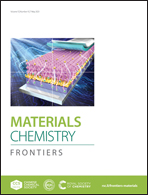Enhanced urea oxidization electrocatalysis on spinel cobalt oxide nanowires via on-site electrochemical defect engineering†
Abstract
Urea electrolysis provides a promising approach for simultaneous energy-saving hydrogen production and wastewater utilization; however, the total reaction rate is severely restricted by the sluggish kinetics of the anodic urea oxidization reaction (UOR). Herein, we report a universal and highly controllable electrochemical defect-engineering approach to enrich the active sites on transition metal oxides toward promoted UOR catalysis. A large number of oxygen vacancies (Vo) were introduced on the surface of a Co3O4 nanowire model-material through negative potential tuning, leading to significantly increased UOR activity of the material. At a potential of 1.34 V vs. RHE, the defect-engineered catalyst delivers an optimal UOR current density of 100 mA cm−2, which is much higher than that (42 mA cm−2) offered by the original Co3O4 catalyst, and outperforms the best reported noble-metal-free UOR catalysts. Experimental results further reveal that the formation of Vo can effectively reduce the charge transport/transfer resistances both inside the nanowires and at the catalyst/electrolyte interface, giving rise to improved UOR activity. These findings suggest the great potential of this electrochemical defect-engineering strategy in the design of defect-enriched catalysts for advanced electrocatalysis.



 Please wait while we load your content...
Please wait while we load your content...